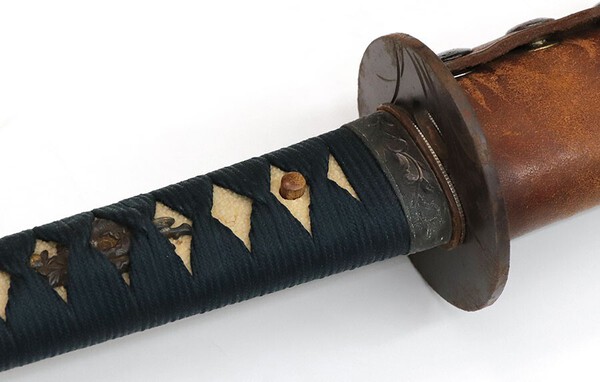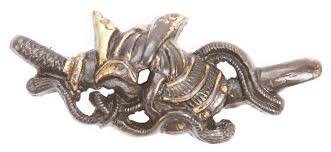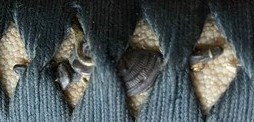-
Posts
981 -
Joined
-
Last visited
-
Days Won
16
Content Type
Profiles
Forums
Events
Store
Downloads
Gallery
Everything posted by mecox
-
KANEHIRA (包平) , real name Gotō Eiji (後藤栄治), from Seki, born December 26th 1916 and registered as a Seki smith on Showa 14 (1939) October 26. . He was a student of Amachi Suzuichi (天地鈴市) who also called Amaike Masatsune (born 1894). In 1942 Banzuke list as joko no retsu.
-
@Slaborde Sara, glad its helpful as members have put some time into it. Of course its always appreciated if folk can make a donation to support costs of running NMB (e.g. big software licence, massive stored database etc). Easy to do at top of page "Donations". Cheers.
-
@Slaborde Sara below is an edited version of your summary hopefully suited to your family history. I cannot offer further to what has been provided. SWORDSMITH KANEYOSHI His swordsmith “art” name is 兼義 Kaneyoshi. His family name is 岡田 Okada and his given name is 武 Takeshi. He was born in the town of Seki in Gifu Prefecture in Meiji 42 (1909) on October 30. From when he was young, around age 14 in 1923 (Taisho 12) he began training in the making of agricultural tools under his uncle who was a qualified blacksmith toolmaker. They likely experimented with making swords at that time, as they made edged farm tools. He later went to Oshu (now called Fukushima Prefecture) in northern Honshu, to train further as a blacksmith, after which he returned to Seki to train as a swordsmith in traditional methods in the tanrenjo forge. He looks to have completed his apprenticeship in 1933 and was then making swords. A 1937 official survey notes he had trained under Niwa Kanematsu Kanenobu (兼信 丹羽 兼松) who was born in 1874 and worked in Kamo-gun in Gifu Prefecture. Kanenobu was an experienced swordsmith who died in 1941 age 67. From around 1935 he took on his older brother 兼定 Kanesada (岡田 定男 Okada Sadao) as a deshi (apprenice); he was born in 1905. The 1937 report notes that at that time Kaneyoshi had his own forge at Otsu in Seki but then did not have an apprentice. In 1939 (Showa 14) on October 20 Kaneyoshi registered as a swordsmith in Seki City and at that time had moved to Yoshida-cho in Seki. He then focused on training new tosho (swordsmiths). Noted students of his were: Okada Kanesada (brother), Ikeda Kanetsuna, Takai Sadatsugu and Isaji Kanehiro. Kaneyoshi became a promoter of traditional sword-making by koshiki tantren (the old style of forging, emphasizing traditional methods and materials). He was then working in the Seki Token Kaisha (company) and was head of the tanren-bu forging section. Later he became a full time employee of Noshu Nipponto Tanrenjo Kabushi Kaisha (share holders). In 1942 he was recorded to be living at Seki-machi, Ikuta-cho. He was well trained in traditional methods and considered to be a well above average swordsmith. During the war he largely produced well made “showa-to” non-traditional blades as required but also some custom traditional Nihonto. As with many swordsmiths he entered Sword Exhibitions, which were judged competitions in which swordsmiths were ranked. 1939: At the 4th Shinsakuto Exhibition his first submission won Kinpai (Gold Medal) 1941: At the 6th Shinsakuto Exhibition there were 250 blades evaluated. He was ranked 4th level of 5 (Chu Jo Saku) (superior medium level) 1942: Tosho Banzuke (national ranking of 400 swordsmiths) 5th level of 7 (Chu Saku) (medium level) 1943: At the 1st Rikugun Gunto Tenran Kai Exhibition run by the Army; 300 blades were submitted. He won Chairman’s Award (Kaicho-sho). Post-war swordmaking was permitted from 1954 and Kaneyoshi registered as a swordsmith on October 12, 1971 at age 62. However, he died on March 15, 1972 only five months later. Based on material in “Nihonto Message Board” and “Japanese Swordsmiths in Gifu 1937, Malcolm Cox, 2021”.
-
John here are some Kanehide both war & post-war links, you may or not have: Core Tokyo Web Japan Sword Japan Sword Sword Noshu Sumi Kanehide (with saber) Showa 20th New Year|Japan Sword Sword Sales E-Sword [e-sword] Sword inscription Noshu Sumitomo Kanesaku June day of Showa 61 Kanehide August | https://isao-machii.org/2017/09/29/兼秀 昭和十八年八月 Sword Noshu Sumikane Hidesaku Showa 46th February auspicious day | KANEHIDE, NAKATA – Yakiba.com 刀剣小町 刀 銘 : 濃州関兼秀作 昭和十七年十月吉日 拵入 (Katana、 Noshu Seki Kanehide saku Showa 17 October day) katana signed Noshu-ju KANEHIDE-saku In the 6th month, the 61th year of Showa - 濃州住兼秀作 昭和四十七年仲秋 Noushuju Kanehide - 日本刀の通信販売 明倫産業株式会社 - Noushuju Kanehide - Mail order of Japan swords Meiren Sangyo Co., Ltd. Yahoo! Auction - [Change] Gifu Prefecture Important Unmarked Cultural Property Kaneshu Showa 19th Year ... Yahoo! Auction - [Yu] Gifu Prefecture Important Intangible Cultural Property Noshu Sumi Kanehide 2 shaku 4 ...
-
Read quickly and was well off with Fujiwara Kanemitsu.......Ganko has it with Inshu Kanesaki
-
@John C @Bruce Pennington John we often see over a 10 year period (1935-1945) that certain smiths mei form and style can change quite a bit, and this seems often the case in Seki/Gifu. These include things like wording of mei, is it katana-mei or tachi-mei, style of cutting some kanji, does yasurime change, and is there any relation (or not) to stamps. This also relates to evolution of their career (e.g. ranking, if RJT, retained as "exclusive" tosho). Certain factors look to be relevant: # who paid for the blade or where sold (e.g. shop, shop custom, individual, officers club). # where was smith working/employed when made (e.g. individual forge, group forge, production workshop, or arsenal). # was blade made for an exhibition or was a donation / dedication (mostly in shirasaya). # the above factors also influence whether blade is Showato, "semi-traditional" or traditionally made Nihonto and what iron/steel was used.
-
I dont think you can assume a month, and so just list under the year, and if date is "Koki ni sen roku hyaku nen" then it is 2600 years (1940).
-
@John C John, here's some notes on "Empire" dates and months. Also in my paper in NMB Downloads of Taguchi Masatsugu (Hizen/Saga) at end are numerous examples he uses in this form.
-
Kirk, better to read this way, and summary from Sesko: KATSUMASA (勝正), Tottori – “Hōki Kanaya Katsumasa saku” (伯耆金谷勝正作), “Hōki-jū Kanaya Katsumasa kore o saku” (伯耆住金谷勝正作之), family name Kanaya (金谷), he also engraved a single coin crest onto his tangs, jōkō no retsu (Akihide), Second Seat at the 6th Shinsaku Nihontō Denrankai (新作日本刀 展覧会, 1941)
-
@John C John, as a matter of interest did you see my paper in Downlaods "Seki Toki Swordsmiths" it has an outline of Kanehide. Do you have these 2 oshigata from Fuller & Gregory 1983.
-
Nice work Jan, and interesting to see him in Sesko lists: NORIMASA (徳正), Keiō (慶応, 1865-1868), Hitachi – “Suifu-jū Inanobe Norimasa” (水府住稲延徳正), real name Kurosawa Sōjirō (黒沢宗次郎), student of Norikatsu (徳勝)
-
@Jake007 @Bruce Pennington Jake based on the nakago only and as noted above smith is Kaneomi and date November, 1943. But the blade almost looks chromed . But here is the smith: YOSHITOMI 義臣 (also read Yoshiomi): real name Takeyama Kazuo (武山数雄). Born Meiji 43 (1910) April 3, younger brother of Yoshinao (義尚). Registered in Seki on Showa 14 (1939) October 27 (age 29). Akihide 1942: Rōkō no retsu (7/7). Example mei: (“Seki Yoshiomi saku”), (“Seki ju Yoshitomi saku” SEKI) (“Takeyama Yoshitomi” SHO) [Slough p.202]. Your mei is 義臣 but interesting is that it has the small Nagoya Arsenal "na" 名 stamp on both sides. Note: I only later saw all the swords posted on this link !
-
@TastyReuben Patrick, interesting kaigunto by YOSHIAKI 義明: real name Mishina Naoichi (三品直市). Born Meiji 42 (1909) July 27. Registered as a Seki smith Showa 14 (1939) October 25 (age 30). In 1940 was a member of Seki Token Kaji Association. In Akihide Banzuke list of 1942 is rank of Ryōkō no retsu (7/7). He has examples with Sho stamp (no date) and Seki stamp (1941) with dragon horimono and bonji which is unusual in war period. Died Heisei 1 (1989) February 5 at age 70. Does not appear to work post-war. Example mei: (“Yoshiaki” SHO) (“Mishina Yoshiaki” SEKI), (“Yoshiaki” “1941” SEKI).
-
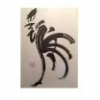
Help identifying sword taken to US after WW2
mecox replied to marked-content's topic in Military Swords of Japan
Mark, not much info found on 松田 兼高 ( note there are several other Kanetaka). He does not appear to have entered many exhibitions, and is not in the 1942 ranking. He was a senior smith in Seki. Born 1911 and independent (finished training) in 1930 is age 19. Seems this training was in the Nippon Tanren Juku and under Kojima Kanetoki (Kanemichi). Early registered in Seki in October 1939. So he would have been producing pre-war and the SHO stamps are from 1939? to 1942? Seki stamp is around 1943. He was a member of Seki Token Kaji Association ("swordsmiths") in 1940. Not found any info from late war, did he stop working for some reason? Here's some examples of yours: [1. Japanese Sword Index, Stein: SHO stamp] [2. Meirin Sangyo: Noshu Matsuda Kanetaka saku has SEKI stamp plus kokuin hot stamp, 68.4 cm / 1.6 cm ] [3. Ikeda Art: Matsuda Kanetaka 71.2 cm 1.8 cm SHO stamp long blade, may be custom] [4. Yahoo Auction: Noshu Seki ju Matsuda Kanetaka saku SHO stamp]. -

My recent purchase - SHIN GUNTO TYPE 98
mecox replied to Krzysio's topic in Military Swords of Japan
Kris, pic better this way. More on swordsmith (also see Naval Swords part 1 in NMB Downloads at top of page for examples) Looks to be well made and saya looks interesting custom work? Kanenaga, Amaike Ginjiro (包永天池 銀次郎) (older brother of Masatsune) born 4 September, 1884 (Showa 17), registered as Seki smith at Seki 15 June, 1941 (Showa 16) and living at Daimon-cho, Seki-machi. He may not have made (many) Navy swords. Kanenaga died March 8th 1958 (Showa 33, his posthumous Buddhist name was Enkaku Chikyō (円覚智鏡). Common mei: Nōshū Seki no jū Kanenaga kore saku (濃州関之住包永作之), Kanenaga (包永) -
Maybe , I think the whole mei and date are cut in a strange way. Earlier discussion on this went on for many posts.
-
@Matt Davis @Bruce Pennington As noted by Bruce looks like Kanesumi Sato sword dated as Showa 16 (1941). However, SEARCH this NMB for some other interesting discussion Kanesumi 兼住 Sato Kohachi 佐藤 幸八 (can also be read “Yukiya”) Born: Meiji 24 (1891) Oct 10 Reg. Registered as a Seki tosho: 1940, Dec 27. Address 1940: Kamo-gun, Kajita-mura. Became Rikugun Jumei Tosho Example mei: Kanesumi 兼住 (1943, Nov) Sato Kanesumi saku 佐藤兼住作 (Sho/sakura stamp) (also Tan stamp, another sword) Seki ju nin Sato Kanesumi saku kore 関住人佐藤兼住作之 Pics below: yours, Fuller & Gregory, Slough.
-
@Nicholas @Bruce Pennington about yasurime, as a rough idea from what i have seen for Kanefusa (23rd) its around 70% takanoha, 20% higaki (criss cross) and maybe 10% sujikai. However, some are poorly filed or bad pics which confused last two types.
-
@Slaborde samegawa/same is a ray/stingray and is good on yours. Later in war there was some use of early plastics in artifical material, and at end of war were using paper/tape/bark etc. Seeing you are chasing info look at following post. There is some terrific material in here, but second one is for you = Encyclopedia....and only $12.50, just what you need.
-
@Slaborde Sara here are some details from the example 6-7-8 I sent you. Your original tsuba could well have been in this style. Also note the menuki, although a different design (flowers) similar style to yours.
-
-
@Slaborde I would call your sword a katana made in WW2 or just before. I my opinion it did not have any gunto (that is "army-sword") fittings and the brass one you posted was added later as a swap. So yes it would look like the one you just posted. There is one bit missing on your saya (scabbard), which was a metal (or bone or wood) ring around the mouth of saya (Koi-guchi "carp mouth"). The original tsuba could have been oval shape iron (or copper) with a simple design of carving keeping with the fuchi-kashira. Others may comment.
-

Help identifying sword taken to US after WW2
mecox replied to marked-content's topic in Military Swords of Japan
Mark, good looking sword and in original state. A good smith from Seki working from pre-war. 兼高 Kanetaka (松田 高市 Matsuda Takaichi) Born: Meiji 44 (1911) September 16; registered as a Seki smith: Showa 14 (1939) October 26. Lived in 1937 at Bugi-gun, Seki-machi, Aza naka-machi. In 1939 at Seki-machi, Naka-machi. History: trained from Taisho 13 (1924) under Kojima Kanetoki (Kanemichi). Became independent (completed traing) Showa 5 (1930) May. Example mei: Kanetaka 兼高 Noshu Seki ju Matsuda Kanetaka saku 濃州関住松田兼高作 For context of his work see Downloads at top of NMB page and find paper on Gifu Swordsmiths -
@Slaborde Sara, have a look at this sword (Kanesada), as a coincidence he was brother of your man (kaneyoshi)
-
Bruce, maybe, but cant see marks of a suspension ring and still has kurikata. To me gunto tsuba is damaged, plus hole for spring clip and seppa are pop-outs. I think more likely someone pinched the tsuba that matched the fuchi-kashira and replaced with gunto. (Again an opinion!!).







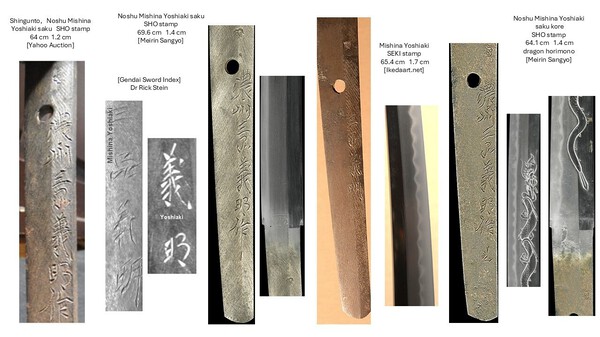





.jpg.100d309ae99885d0f310a7cbf44ca225.jpg)

